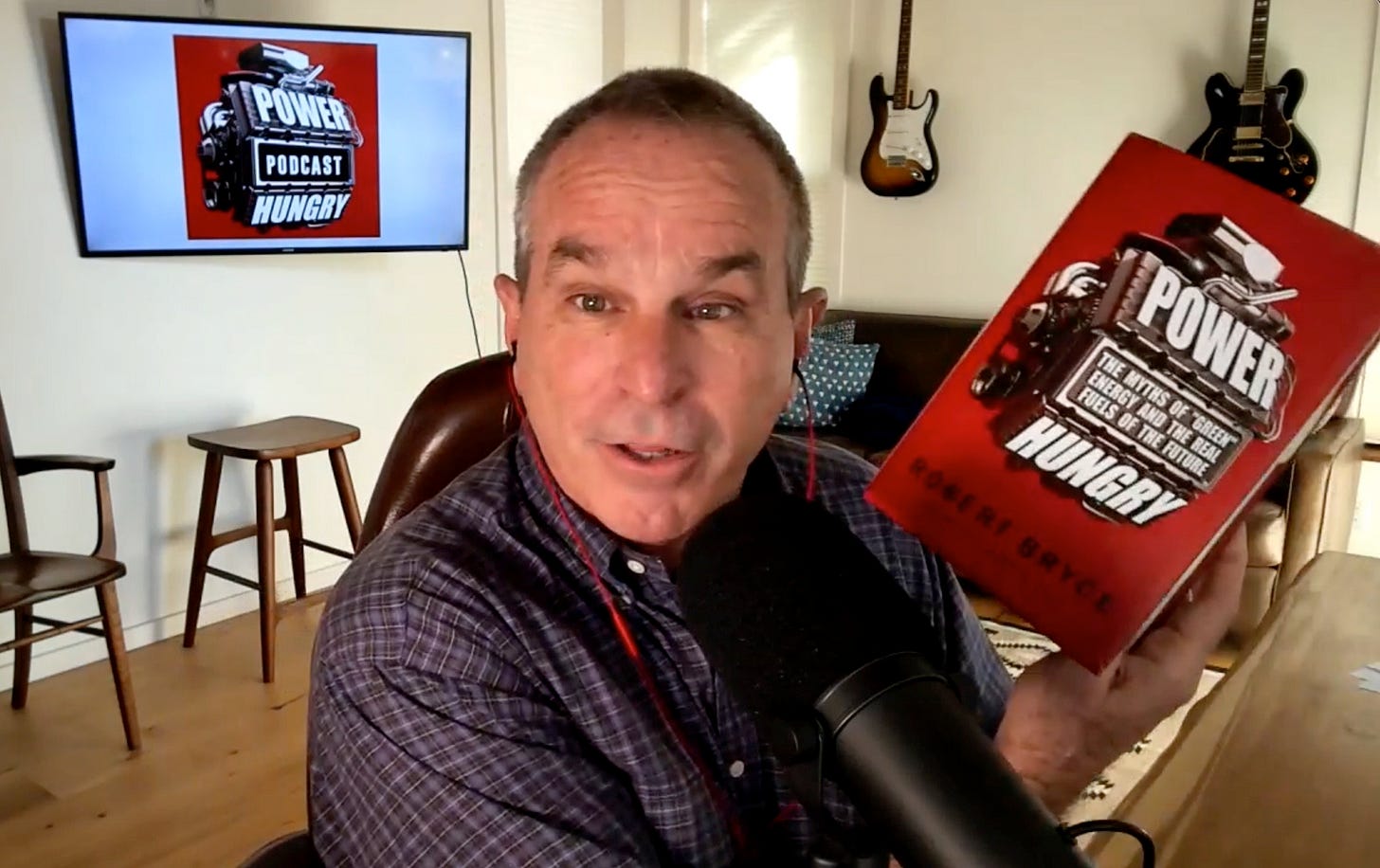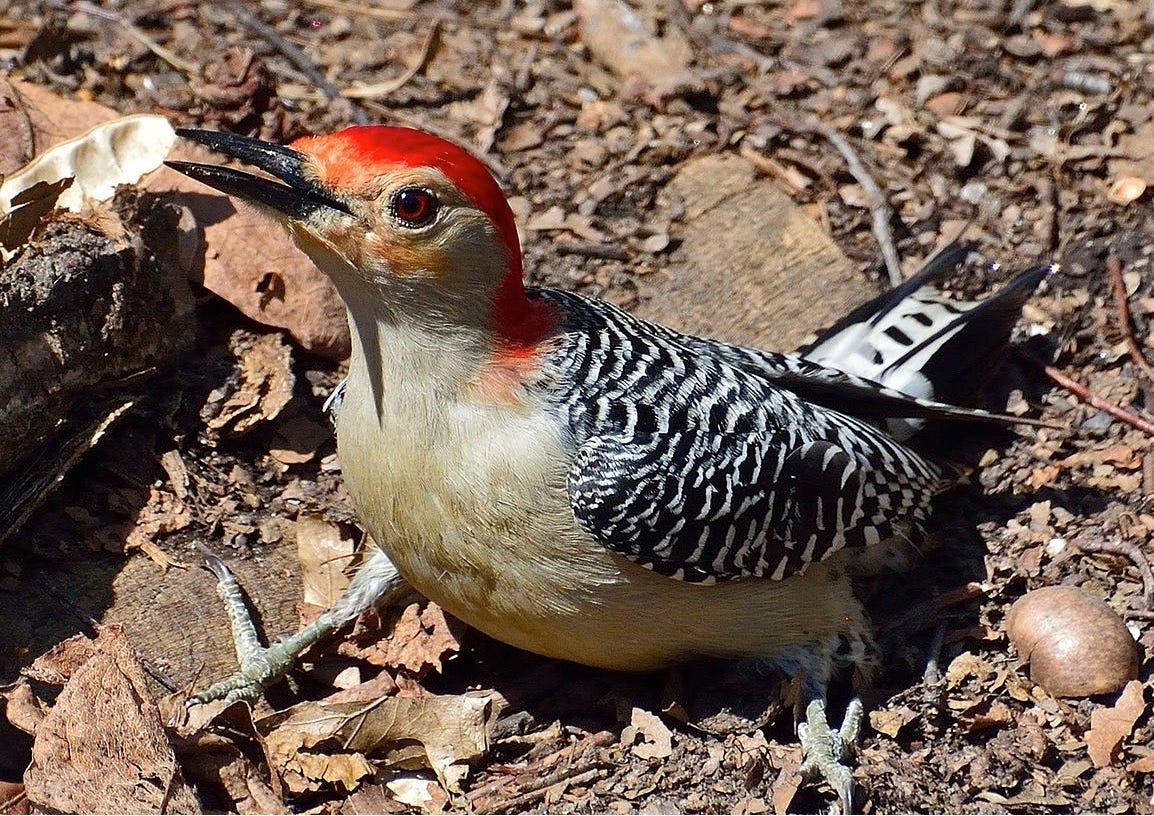Ridley talks Viral, Forbes pieces, new power brief, and Red-bellied Woodpeckers
Matt Ridley on the origins of Covid, two new Forbes pieces, new Power Brief on the EU, and woodpeckers!
Happy 2022. Let's hope it's a better year than the train wreck that was 2021. It was a joy to have our children come home for Christmas. But it’s also great to have a quiet house and to get back to work. Lorin is back teaching art full time and I am glad to return my focus to writing, preparing speeches, recording podcasts, and planning for 2022. Lots happening, so I’ll cut to the chase. Five items today:
Matt Ridley on the podcast talking Covid, Omicron, and birding in Kenya
Forbes piece: EU wakes up to N2N
New Power Brief on the EU's decision
Forbes piece on top energy stories from 2021
Red-bellied Woodpeckers at the sewage treatment plant
The photo above was taken by Ken Thomas in North Carolina in 2007.


Matt Ridley on Covid, Omicron, vaccines, lab leaks, and...the Black-chested Snake Eagle
Perhaps the biggest joy of my job is getting to interview interesting people. And Matt Ridley is among the most intriguing and interesting people I’ve been privileged to meet and interview.
Ridley is one of the world’s foremost science writers. A former member of the House of Lords, he’s author of ten books, including his most recent one, co-authored with Alina Chan, Viral: The Search For the Origin of Covid-19. In this episode, he discusses why the pandemic may -- repeat may -- have been caused by a lab leak in Wuhan, China’s efforts to suppress information, how “open-source analysts” helped expose the origins of the virus, vaccine development, and why Covid may eventually “become the common cold.”
Viral is a terrific book. I highly recommended it. Matt and Alina Chan cover an incredibly complex subject and do so in a way that makes it read like equal parts detective novel, biology lesson, and political inquiry. That last part is key because China’s totalitarian government has gone out of its way to suppress information about the origins of the worst public health crisis in modern history. During our talk, Matt underscored this point: by repeatedly entering bat caves to collect viruses, the scientists at the EcoHealth Alliance and the Wuhan Institute of Virology, may have helped cause a pandemic that they were, in theory, trying to prevent. This wasn’t as Matt explained, due to nature encroaching on people, but instead, it was due to the “huge amount of encroachment by scientists on wild bat populations.”
It wasn't all pandemics and viruses. Matt and I also talked about birds. He’s recently returned from Kenya where he saw, among many other species, the Black-chested Snake Eagle, which is an awesome bird moniker.
It was a fascinating discussion. I like to keep my podcasts to about an hour, but there was so much to discuss that Matt and I talked for about 1 hour and 20 minutes. Again, here’s a link to the podcast. You can also watch the episode on YouTube. Please share the links and while you are at it, subscribe to my YouTube channel.
Want to subscribe to this "news" letter? It's free. Click here.


On Wednesday, I published a piece in Forbes about the European Commission’s decision to designate natural gas and nuclear as sustainable investments. I began:
Finally, the European Union has admitted the obvious: if decarbonization is the goal, natural gas and nuclear must be a big part of the continent’s energy mix. On Saturday, the European Commission released a statement which said “there is a role for natural gas and nuclear as a means to facilitate the transition towards a predominantly renewable-based future.” The move means that gas and nuclear could be classified as “sustainable investments” under certain conditions. This is good news and a tacit acknowledgment by European policymakers of the energy disaster that is now shaking the region. But it’s also far too late in coming. Indeed, my immediate response was to ask: what the heck took them so long? If decarbonization is the goal, then natural gas and nuclear are the obvious ways forward.
I continued:
I am not bragging here, but I must note that I have been touting N2N — natural gas to nuclear — as the best “no regrets” policy for more than a decade. Natural gas and nuclear are not “bridge fuels” or “transition” fuels, they are the fuels of the future. Why? They are low- or no-carbon, have small footprints, are affordable, and scalable. In my third book, Gusher of Lies, published in 2008, I wrote that nuclear could provide “large increments of low- or no-carbon electricity to the world’s energy mix over the next couple of decades. Nuclear is the only sector that has enough momentum and enough capital behind it to make a significant dent in the overall use of fossil fuels.” I also explained that the world has a “surfeit of natural gas and more gas is being discovered all the time.” I continued, saying environmental groups “should applaud the increased use of natural gas as it is part of the ongoing ‘decarbonization’ of the world’s energy mix,” and that natural gas should be the dominant fuel of the 21 century. And that dominance should be welcomed.”
In 2010, in my fourth book, Power Hungry, I have a chapter called “Why N2N? And Why Now? (The Megatrends Favoring Natural Gas and Nuclear). In 2011, I published a 14-page report titled “Ten Reasons Why Natural Gas Will Fuel The Future.” In 2014, I published my fifth book, Smaller Faster Lighter Denser Cheaper, which has a chapter titled “Climate Change Requires N2N.” I wrote, “Regardless of what you think about carbon dioxide or the climate-change debate, it’s apparent that the best way forward is to embrace N2N.”
In my latest book, A Question of Power, published in 2020, I have a chapter called “The Nuclear Necessity,” in which I repeat one of my favorite lines: “If you are anti-carbon dioxide and anti-nuclear, you are pro-blackout. There is simply no way to slash global carbon dioxide emissions without big increases in our use of nuclear energy.” I concluded that N2N “provides the best no-regrets policy on climate change because those two sources will have minimal negative impacts on the economy and environment while providing significant decarbonization.”
To be clear, I am not gloating or bragging here. I am truly pleased that policymakers in Europe are, finally, embracing energy realism. It is about time.
Again, here’s a link.

New Power Brief on EU decision
Last night, I published a 5-minute Power Brief as a follow-up to my Forbes article on the EU’s decision to consider natural gas and nuclear as sustainable investments. I added a few details in the video that I didn’t include in the Forbes piece. I like doing these short videos as they give me a chance to be less formal and to add content to my YouTube channel. In any case, have a look.


On New Years Eve, I compiled some of the notable energy stories of 2021 and published the piece in Forbes. There were plenty of issues to choose from and, in hindsight, I know that I omitted some key ones, including ones that I covered in the Wall Street Journal, including the surging number of blackouts and China’s dominance of rare earth elements. Nevertheless, here’s what I wrote:
It has been a chaotic year in the energy sector. And with just a few hours left in 2021, I put together my list of the most important energy developments of the year. It’s a personal list and not meant to be comprehensive. So without further ado, my top seven stories of the year.
The Texas Blackouts Demonstrate the Foolishness of the “Electrify Everything” Push. This story is first because it’s personal. On February 15, our home in central Austin was blacked out. Our power stayed off for 45 hours. The post-mortem of the blackouts has been ugly. Yes, some natural gas supplies were unavailable due to the cold weather. But the reality is that some $66 billion was spent on wind and solar projects in Texas in the years before the blackout and yet when the ERCOT grid was on the verge of collapse, effectively none of that renewable capacity was producing power. State regulators are still wrestling with how to assure blackouts don’t happen again this winter. But it is clear that the Texas grid is not as robust as it should be and it is being fragilized by the addition of too much renewable capacity and not enough thermal capacity. Texas is only part of the story. As I wrote during the power outage, “This blizzard proves that attempting to electrify everything would be the opposite of anti-fragile.
The second story:
Coal Comes Roaring Back. A few years ago, I debated Jigar Shah, a solar-energy promoter and founder of SunEdison, who now directs the loan programs office at the Department of Energy. Shah contended that coal was dead and that solar was going to take over the world. Yes, well. Solar has grown over the past few years. But coal, the fuel that Thomas Edison used on Pearl Street and that climate activists have disparaged for years, keeps on keeping on. Earlier this month, the International Energy Agency reported that “global coal power generation is on course to increase by 9% in 2021 to 10,350 terawatt-hours (TWh) – a new all-time high.” The agency also reported that “coal demand may well hit a new all-time high in the next two years.” According to the IEA, three factors are driving the surge in coal use: the quick post-pandemic rebound in the global economy, a cold winter followed by a hot summer, and weather conditions that pushed natural gas “prices to all-time highs, raising demand for coal for power generation.” While those factors are driving coal demand, the continuing use of the carbon-heavy fuel proves yet again, what I call the Iron Law of Electricity, which says “People, businesses, and countries will do whatever they have to do to get the electricity they need.” Love coal or hate it, it’s going to stick around for a long time to come.
I included five other stories, including:
Solar Sector’s Dependence on Uyghur Slave Labor Gets Exposed
Europe’s Energy Suicide
Nuclear Plant Closures in Germany and New York
The Energy Cluelessness of the Biden Administration
The Backlash Against Big Wind and Big Solar Gains Momentum
Again, here’s a link.

Woodpeckers at Hornsby Bend
As I have mentioned in previous editions of this “news” letter, one of my favorite birding spots in Austin is the sewage treatment plant. The Hornsby Bend Bird Observatory is located downstream of the city on the banks of the Colorado River. It is part of the city’s Hornsby Bend Biosolids Management Plant. We always see birds there, including duckloads of waterbirds, which are attracted by the large settlement ponds on the site. The 1,200-acre site also has lots of bottom-land hardwoods. A few months ago, I got my first (and only) glimpse of the Pileated Woodpecker, the largest woodpecker in North America. On our visit on New Years Day, Lorin and I saw large numbers of American Coots and Northern Shovelers on the ponds. We were also delighted to see a trio of Red-bellied Woodpeckers (Melanerpes carolinus). (The photo above was taken by Spinus Nature Photography in Central Park, New York City, in 2015.)
Woodpeckers are pretty common around Austin. We’ve seen them at our feeders and birdbaths. But like lots of other birds, they are complex creatures. As this site explains, woodpeckers have very small brains, weighing about 0.07 ounces. “Bigger brains have more mass, which increases the risk of brain damage, so their smaller brains are protected. The design of their skulls is also beneficial for several reasons. The frontal bones of their skulls work in conjunction with a pair of muscles at the base of their bills to act as a shock absorber...In addition, the outside of their skulls is made up of dense bone, while the inside is more porous...When the woodpeckers are pecking, the force is distributed all around the skull, which helps keep the additional pressure off the brain.”
Wikipedia says the Red-bellied Woodpecker is
a medium-sized woodpecker of the family Picidae. It breeds mainly in the eastern United States, ranging as far south as Florida and as far north as Canada. Its common name is somewhat misleading, as the most prominent red part of its plumage is on the head; the Red-headed Woodpecker, however, is another species that is a rather close relative but looks quite different. Males tend to call and drum more frequently than females, but both sexes call. The drum sounds like 6 taps. Often, these woodpeckers "drum" to attract mates. They tap on hollow trees, and even on aluminum roofs, metal guttering and transformer boxes in urban environments, to communicate with potential partners...These birds mainly search out arthropods on tree trunks. They may also catch insects in flight. They are omnivores, eating insects, fruits, nuts and seeds. Their breeding habitat is usually deciduous forests. They nest in the decayed cavities of dead trees, old stumps, or in live trees that have softer wood...Areas around nest sites are marked with drilling holes to warn others away.”
Have a great weekend.
Want to subscribe to this "news" letter? It's free. Click here.
Want to help?
1. Share this email to your friends and colleagues. Or have them email me so I can add them to my distribution list.
2. Subscribe to the Power Hungry Podcast.
3. Rent or buy Juice on iTunes or Amazon Prime.
4. Buy A Question of Power: Electricity and the Wealth of Nations and give it a positive review.
5. Follow me and Juice on Twitter.
6. Need a speaker for your conference, class, or webinar? Ping me!
Watch Juice for free on Roku!
If you haven't seen our documentary yet, here's a reminder: you can watch Juice: How Electricity Explains the World, on Roku Channel, for free. Just click this link. If your friends haven't seen it, send them a link. Or if you have a prime membership, you can watch it on Amazon Prime.



